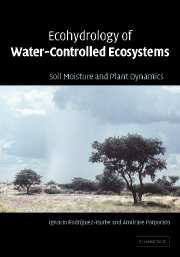Book contents
- Frontmatter
- Contents
- Foreword
- Preface
- 1 Introduction
- 2 Stochastic soil moisture dynamics and water balance
- 3 Crossing properties of soil moisture dynamics
- 4 Plant water stress
- 5 Applications to natural ecosystems
- 6 Coupled dynamics of photosynthesis, transpiration and soil water balance: from hourly to growing-season time scale
- 7 Plant strategies and water use
- 8 Seasonal and interannual fluctuations in soil moisture dynamics
- 9 Spatial scale issues in soil moisture dynamics
- 10 Hydrologic controls on nutrient cycles
- 11 Hydrologic variability and ecosystem structure
- References
- Species Index
- Subject Index
- Plate section
10 - Hydrologic controls on nutrient cycles
Published online by Cambridge University Press: 14 October 2009
- Frontmatter
- Contents
- Foreword
- Preface
- 1 Introduction
- 2 Stochastic soil moisture dynamics and water balance
- 3 Crossing properties of soil moisture dynamics
- 4 Plant water stress
- 5 Applications to natural ecosystems
- 6 Coupled dynamics of photosynthesis, transpiration and soil water balance: from hourly to growing-season time scale
- 7 Plant strategies and water use
- 8 Seasonal and interannual fluctuations in soil moisture dynamics
- 9 Spatial scale issues in soil moisture dynamics
- 10 Hydrologic controls on nutrient cycles
- 11 Hydrologic variability and ecosystem structure
- References
- Species Index
- Subject Index
- Plate section
Summary
In this chapter we turn to the study of the cycles of organic matter and nutrients in soils. Such dynamics are extremely important for the life and growth of vegetation in water-controlled ecosystems and, as will be seen, the role of hydrology is paramount with an intricate series of linkages and feedbacks at various levels within the system.
Since plants in water-controlled ecosystems are often both water and nutrient limited, it is difficult – if not impossible – to determine the extent to which net primary production is controlled by water or nutrient availability. Water scarcity heavily contributes to nutrient deficit through a series of different mechanisms, so that an understanding of plant stress requires a joint analysis of water and nutrient cycles. As noticed by Pastor et al. (1984), the nitrogen cycle needs to be explained through the water balance. The latter in turn depends on the existing type of plant, which determines the litter composition and so on.
Although the importance of the interaction between nutrient cycles and hydrology has been recognized for a long time, its consequences are far from being completely understood. Soil moisture, which is itself the result of the joint action of climate, soil, and vegetation, controls both directly and indirectly the soil carbon and nitrogen cycles. Directly, it impacts some of the most important phases of these cycles, such as decomposition, leaching, and plant uptake; indirectly, through its influence on vegetation growth, soil moisture affects the amount and composition of plant residues.
- Type
- Chapter
- Information
- Ecohydrology of Water-Controlled EcosystemsSoil Moisture and Plant Dynamics, pp. 306 - 359Publisher: Cambridge University PressPrint publication year: 2005



